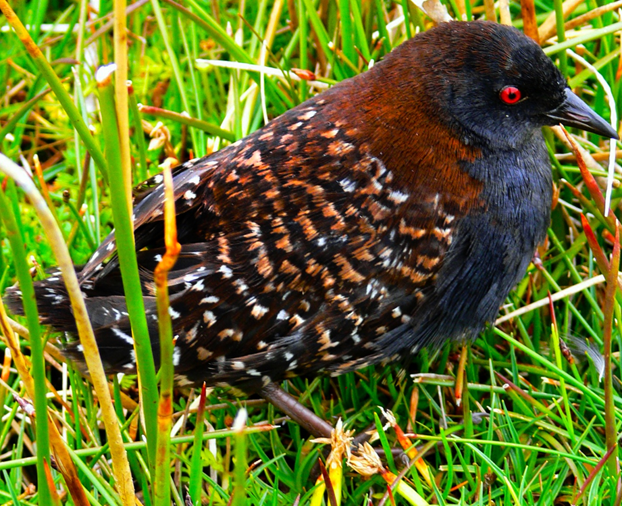SOUTH JERSEY — It is a tiny marsh bird, no bigger than a sparrow.
The Black Rail is one the most mysterious and elusive water birds in New Jersey’s coastal marshes. Only the size of a sparrow, this diminutive bird skulks around at night, often using trails made by mice to travel through dense marsh vegetation. Seeing one in flight is a rare event.
New Jersey Audubon is trying to find this rare and threatened bird in the state because its numbers appear to have declined dramatically over the last 30 years throughout the Atlantic Coast region. The last organized survey for the species New Jersey Audubon conducted was in 1988.
This summer, New Jersey Audubon completed its third breeding season survey for Black Rails. Armed only with MP3 players, more than 30 volunteers spent more than 500 hours broadcasting the distinctive “kee-kee-kerr” call of the Black Rail in the dead of night. If a male hears the call of a rival (or one played by a researcher) near its territory, it calls back, which means “citizen scientists” and biologists can identify them, even if they can’t see them.
“It is very rare for you see the bird,” Mizrahi said. “For this survey, 99 percent of time the birds are heard, not seen.”
Between May and July each year, surveyors visit each site three to five times, hoping the numerous visits will increase the chance of detection. Bird watchers station themselves along roads, waterways, and other places with suitable marsh habitat, as well as track the marshes by boat.
Surveys to find these secretive birds were conducted throughout Cape May, Atlantic, Ocean and Cumberland county marshes, resulting in 20 nesting pairs being detected. Top encounter locations were Barnegat Bay, the Delaware Bayshore, the Tuckahoe/Great Egg Harbor watershed and the Mullica River watershed.
“The results of this project will have important implications for conservation and management of Black Rails throughout the region,” said David Mizrahi, vice president of research for New Jersey Audubon. “This is a bird that was much more common in New Jersey 30 years ago, yet New Jersey appears to be the stronghold for the species in the entire Mid-Atlantic region.”
The search has not been easy: there are more than 1,200 possible survey points in the state that must be visited at night; and then there are the mosquitoes to cope with. To date, New Jersey Audubon’s biologists and citizen scientists, working in collaboration with state biologists, have been able to cover only 200 points because of limited manpower and funding. Survey locations visited during the past three years also included points used during the 1988 survey.
Similar studies have been undertaken on the coasts of Maryland and Virginia in recent years, but have detected far fewer Black Rail than in New Jersey, Mizrahi noted.
He believes the reduction in the number of Black Rails is due, in part, to sea level rise and existing coastal marsh management practices. For example, he said, mosquito commissions in New Jersey used to create linear ditches and employed other techniques in coastal marshes to spray for the insects. These marsh management practices changed the hydrology, resulting in tidal waters moving deeper into the marshes. Black Rails thrive in the higher, drier marsh areas that aren’t regularly flooded during high tides.
To preserve the Black Rail, Mizrahi said, there needs to be changes in marsh management strategies in New Jersey. Restoration that increases marsh elevation, adds vegetation and reduces flooding of drier parts of the marsh are key components.
Man-made ponds, known as impoundments, are scattered throughout marshes along the Atlantic coast. Water levels in these impoundments are regularly controlled to create habitat for wildlife, like waterfowl.
“Lowering water levels to create habitats preferred by Black Rails could make it possible for the species to increase its numbers and eventually – and hopefully – thrive,” Mizrahi concluded.
Cape May County – Why don't we have a local TV station in South Jersey? We had channel 40 in Linwood and that's gone. Maybe because it highlighted real news at times!! With all due respect to the Cape May…








